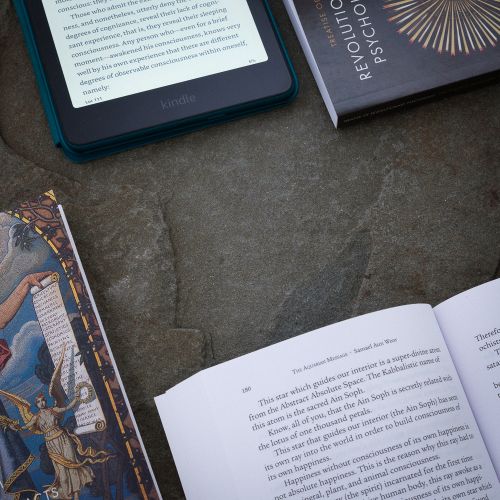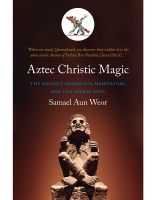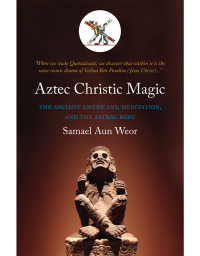Xiuhtecuhtli
The causal plane1 is the book of the memories of God. The duplicates of all gods, humans, animals, and things that have existed upon the Earth abide within it. Xiuhtecuhtli as an allegorical monolith is found within the causal plane; he is the god of fire, of the year, of time, and father of all gods who dwell in the Tlalocan.2 Xiuhtecuhtli is one of the many names of Ometecuhtli; this is related with his aspect as Old God (Huehueteotl).
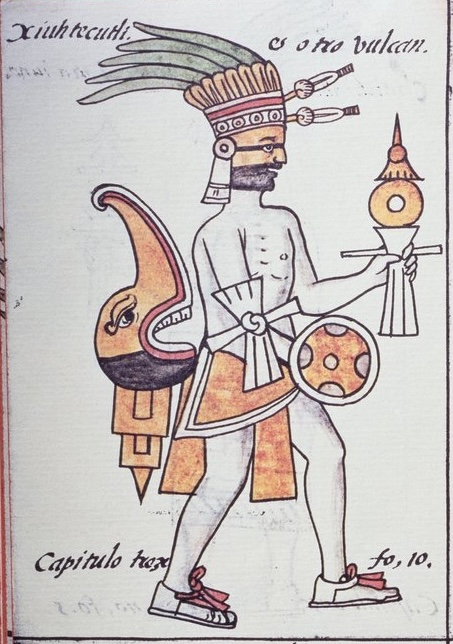
Xiuhuitl: “herb, year”; Tecuhtli: Lord; “Lord of the herb and the year.” The Nahuas represented him wearing a heavy crown filled with attractive colors; a flap-apron made with tassels of quetzalli and feathers in the form of fiery flames; turquoise earrings; on his back, a dragon made with feathers of quetzalli and seashells; holding in his left hand a golden shield with a chalchiuitl cross in the center, and holding in his right hand a scepter with a disc perforated in its center and two globes upon its crest. The perforation in the center of the disc symbolizes that God pours his fire on the Earth through the Sun.
In another representation of Xiuhtecuhtli, the double face of this vermilion god emerges from the water; the Earth is in the center of the universe, and around it the star Venus—or the evening star—and the moon make their journey through the dusty roads of the sky. In another representation, Xiuhtecuhtli appears in the air with a double fiery face traversing through space.
The masters invoked him while pouring three amphorae of water upon the great fire of the temple’s altar. Xiuhtecuhtli answered their supplications.
“Ask, and it shall be given you... knock, and it shall be opened unto you.” —Matthew 7:7
Chalchihuitlicue
Chalchihuitlicue: “emerald, precious thing; one who has a skirt made of emeralds.” She is the goddess of water and the spouse of Tlaloc. The Nahuas represented her as young and beautiful with a golden tiara, petticoat, and mantle with tassels made with quetzalli feathers. A precious nymph with a cleft tongue (symbol of light) appears in the hieroglyphic which adorns her skirt within the interior superior facade of her thighs.
The masters invoked her in summer when the rivers were dried because of the drought. They placed a mound of sea salt upon the altar of the temple; this way they devotedly entreated her assistance. Afterward, a master, while in ecstasy, visited the dried ground of some nearby river and with his magic wand he opened two small holes in the soil, one hole close to the other, and filled them up with liquid copper that was previously melted by the adepts. Then the master repeated the invocation, and with his hands he widened one of the holes; thereafter, the water sprouted from the ground of the dried river and started to flow.
Tlaloc
Tlaloc is the god of rain. Tlalli means “ground,” octli means “wine”: “the wine soaked up by the ground.” The Nahuas always represented him in the “house of the Moon,” his countenance covered by a sacred mask which only allowed his blue eyes to show through it; naked arms and legs with golden bracelets on his calves, and blue cactlis; long hair falling upon his shoulders; a golden diadem adorned with white, green, and red feathers and a necklace made with jade beads; a blue tunic upon which lays mesh netting, the edge of whose rhombus shape is bordered with flowers; he holds with his left hand a blue shield upon which the four petals of a beautiful red flower open; he has in his right hand symbols of hail and lightning in gold and painted with red. He has two glasses held by blue props on both sides, which symbolize the water and the moon.
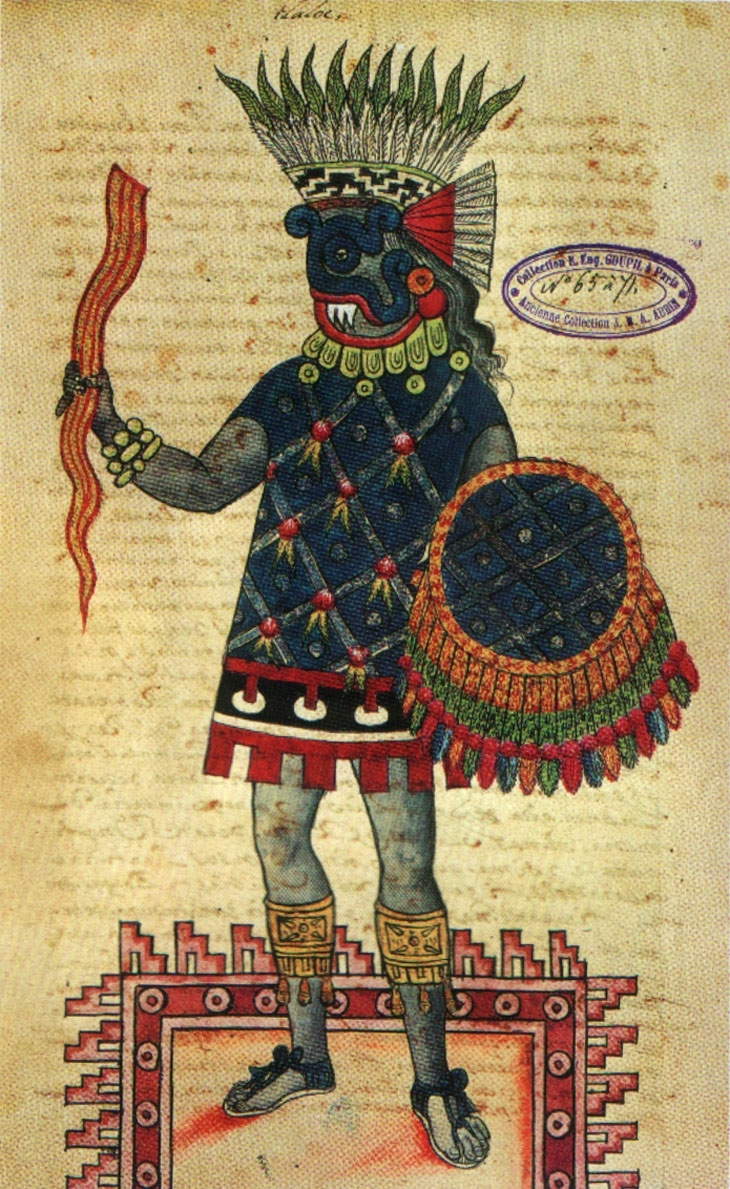
This god had places of worship in the major temple and on the summit of high mountains of the valley of Tenochtitlan. Never was the fire missing upon his altars. The masters invoked him to express their gratitude for the abundance of their harvest, and also to ask him for rain during the great droughts or to melt the hailing clouds. You, dear reader, if you wish, can also invoke him during great rainstorms, but you must do it with faith and reverence.
Ehecatl
Ehecatl, god of the air, of the wind, and of the night is an invisible and untouchable deity. He is Quetzalcoatl in another of his aspects. The Nahuas represented him with a mask of death and an enormous skull, bare with a mouth of elongated lips from which the wind was blown.
When the air was blowing from the East, there where Tlalocan, Paradise, is found, they then named him Tlalocayotl; when the air was blowing from the North, where Mictlan, the Inferno, is found, they then named him Mictlapaehecatl; when the air was blowing from the West, there where the place of women who die in parturition is found, they then named him Cihuatlampaehecatl; and when the air was blowing from the South, where the place of the goddesses is found, they named him Huitztlampaehecatl.
The masters invoked him by lighting three candles made with virgin-wax upon the altar of the temple. Ehecatl teaches how to travel in the astral body. He helps in small and great journeys, in our daily labor, etc. If we beseech him, he can then remove an old sickness from us, or an evil spell, or a bad friend, or a bad neighbor, etc.; however, Ehecatl demands payments for what he grants. Whosoever asks something from him has then to perform unselfish and good deeds among people without considering their race, creed, or class.
Nonetheless, for the tlamatinime Nahuas, who taught that the human being can only find the truth through flowers and chants, Xiuhtecuhtli, Chalchiuitlicue, Tlaloc, and Ehecatl are not a sum of gods, but numbers, laws, forces, attributes, effluvia, and thoughts of God, because none of them is the true God, Ipalnemoani.
Ehecatl was present in the resurrection of the divine Master Jesus as a symbol of universal movement. An arcanum is enclosed within it. Read John 12:1-7 and John 19:38-42, and as part of the text of this present chapter, read in the Bible chapter 18 of Kings and the 24th of Luke.
When the physical body is submitted to the “ordeal of death,” it is anointed with an ointment of vegetal origin whose plants are known only by the masters; this ointment—that conserves intact the silver cord (a cord that keeps the physical body alive and united to its Being) together with the sublimation of the sexual forces—produces the Elixir of Long Life, allowing the initiate to invoke his own physical body three days after his passing away and at the very rim of his tomb. The physical body obeys and, hidden by the veil of the fourth dimension, comes out of its tomb to be anointed with drugs and ointments prepared by “holy women.” Afterwards, the physical body rises and penetrates through the coronary chakra of the Being’s astral body.
We have stated that the masters who renounce the ineffable joy of the Absolute apparently die; yet, indeed, they do not die. They continue living eternally with the same body with which they were living among human beings. The divine Master Jesus lives in Eastern Tibet in the lost city with many other masters, and he makes himself visible in the physical world wherever and whenever he wants.
All the idols from all pagan religions fell from their altars in the very moment of the resurrection of Master Jesus. In Greece, the Oracle of Delphi became mute. In the submarine caverns of the island of Crete, the Minotaur was found dead, whose priests, sneakily, were presenting vestals to him so that he could nourish himself with them. The mystical warrior rites from the Tenochcatl were born dead, in which the hearts from the prisoners of war were snatched away to offer them in holocaust to Huitzilopochtli.
Practice
Choose one of the rooms of your home, or a place in your bedroom, on which you will place a small desk or table so that it will serve you as an altar where, at the light of two wax or paraffin candles, you will devotedly study, from now on, the chapters of this book. Being alone, and after praying, you will invoke the cosmic masters and ask them for help and inspiration.
Sit down; while in a meditative attitude, see and feel that the sacred fire of the Holy Spirit continues rising from the laryngeal chakra up to the portentous chakra of your pituitary gland (the eye of the prophet situated between your eyebrows) and that the fire lights and is in motion from left to right (clockwise); this is your bicolor lotus with two very fine petals that look like arrows, and whose lotus center has a very tiny, little navel.
The chakras are points of connection through which the divine energy circulates from one to another vehicle of the human being. These shine dimly in the human being who is not spiritually developed; yet, in the initiate, they shine effulgently like small suns that spin upon themselves. From now on, concentrate in the chakra Ajna during your moments of meditation.



